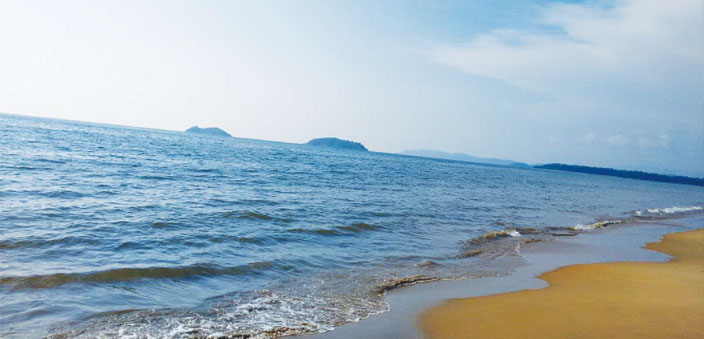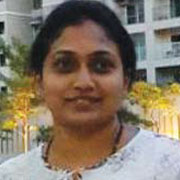The journey from Mangalore to Goa by road, along the western coast of Karnataka was thrilling. Just before we reached Goa, we came across a town beside the sea and we couldn’t resist stopping there, as the sight was amazing. The cool breeze blew in the fragrance of the sea towards us and we realized that we were in the town of Karwar. Karwar is a small town situated in the northern part of Karnataka. It is a town located between the state borders of Goa and Karnataka, on the bank of the river Kali; it is at this place that river Kali meets the Arabian Sea. The Kali Bridge was built in 1986 over the Kali River.
The town and its people
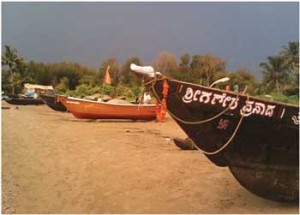
The word Karwar is derived from the Konkani word Kadwad, Kade means ‘last’ and ‘wado’ means land, or the last piece of land. It is also known to be derived from the Marathi word ‘kaarwan’, meaning the corner of land mass before the Kali River. The geography of Karwar is such that it is has land side hills and ocean side islands that naturally protect it from cyclonic weather. Karwar has a relatively warm temperature ranging from 23 degree to 36 degree Celsius.This temperature is suitable for certain crops that are grown only in this area.
Konkani is the native language of the people living here, who also speak Marathi and Kannada. As history reveals, Uttara Kannada district was a part of Bombay state during the British rule, and hence several Marathi medium schools were established in Karwar. Later, when the Konkani language was established as an independent language, Karwar became an integral part of Karnataka. The Dutch, Portuguese, French and later, the British visited Karwar and traded muslin, cotton cloth, black pepper and cardamom.
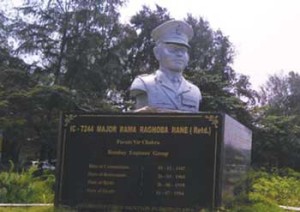
who displayed exemplary courage during the 1971 Indo-
Pak War
The Karwar economy
Karwar is an agricultural region and its economy derives mainly from growing rice, groundnuts and vegetables. Sericulture, horticulture and fishing are the other primary industries. Fishing is an important occupation and almost all varieties of fish and other sea creatures like squids, crabs, oysters, etc form the regular catch of fishermen. Goldsmithing is another important occupation of people here, they are engaged in designing of jewellery and manufacturing them. The nuclear power plant at Kaiga has provided employment to many locals. The place has great tourism potential which remains unexplored.
The Karwar Port
The Karwar Port is located at Baithkol and is operated by the Government of Karnataka. The length of the port is 355 mts.The port has liquid storage tanks for furnace oil, and molasses, it also has a jetty for fishing vessels. An interesting tidbit? The Hindi film Golmaal returns was filmed at Karwar Port!
The Indian navy operates a naval base at Karwar. It is the navy’s third largest base and was founded as a part of Project Sea Bird. During World War II, Karwar was a naval training centre.
The Karwar Beach
The beach is vast and is visited by the locals in the evening and a few tourists can also be found capturing the sea in their lenses, overall presenting a very restful scene. The beach has a variety of sea shells of different sizes and colours and is surprisingly well maintained. It also has various attractions like the park adjacent to the beach, a huge war ship INS Chapal, which was used as a missile boat during the India-Pakistan war in 1971 and converted into a museum since November 2006. A statue of Rama Raghoba Rane has also been installed at the beach. Rama Raghoba Rane was born on 26 June 1918 at Chendia, Karwar. He was a Second Lieutenant and served the Indian Army for 21 years. He was awarded the Param Vir Chakra for his courage and gallantry during the 1971 war against Pakistan.
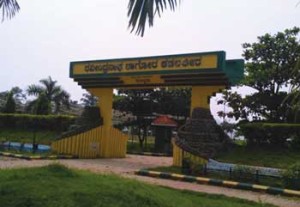
The beach also offers a platform to various cultural events as many of them are staged here. The Karavali Utsav or the coastal festival is held once in a year at the beach and encourages the cultural diversity of the coastal regions. As part of the festival, various cultural programmes are staged and diverse stalls are put up where one can buy handicrafts, food, fabric etc. It is also a means of entertainment not only to the locals but also to the people of the surrounding villages and towns. We were lucky to have a glimpse of a hovercraft which was anchored at the beach for maintenance.
The Karwar Beach and the Tagore connection
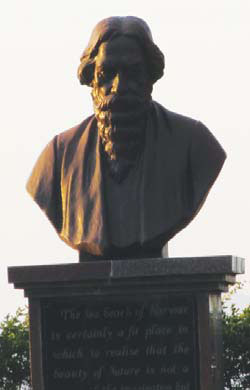
The Karwar beach is known as the Rabindranath Tagore beach as he described Karwar as the ‘Kashmir of Karnataka’. The nobel laureate spent time at Karwar in 1882 at the age of 22,when he lived with his second brother Satyendra Tagore who was at that time a district judge in Karwar.
The view from the beach is mesmerising. The waves rush on to the shore bringing in a large gust of water each time. The sky appears to be painted in vivid colours as if the various colours are mixed and matched on a canvas, displaying the various expressions and moods of life. No wonder the beach attracted the great noble laureate who wrote, “The sea beach of Karwar is certainly a fit place to realise that the beauty of nature is not a mirage of imagination, but reflects the joy of infinite and thus draws us to lose ourselves in it”. A statue of Tagore has been installed at the beach to pay homage to the great man.
Fish, fish and more fish
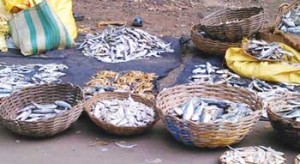
Karwar is known for its sea food as fish is easily available, and it is the staple food of people here. Rice along with fish prepared with coconut is a hallmark of the Konkani cuisine.The fish varieties most commonly available are mackerel, pomfret, king fish and sardines, besides other sea foods like prawns, squid, oyster and crabs. The locals here prefer to cook food at home in their traditional methods. There are a few restaurants that cater to various seafood cuisines in the traditional way ,and a must try are certain dishes like ganshe shaak served with paraboiled rice, tissare sukke (a dish made of oyster), kurale ambat (crab curry), alambya ambat (mushroom curry) and maasali fry (fish fry), as it is known here in the local language. The menu in the dessert section consists of the patoli (rice pancake boiled in turmeric leaves as it gives a distinct fragrance) and sukrondo ( a delicacy made of channa dal/moong dal and jaggery stuffing which is coated with gramflour batter and deep fried); these dishes are unique and are prepared mainly during festivals. The meal is completed by kokam kadi which is a drink prepared from the kokum fruit and is said to soothe the digestive lining and also aids in digestion. Kokum trees grow in abundance in Karwar and the dried fuit is used in a number of dishes, especially sea food curries to give it a tangy flavour. Karwar is a wonderful place for sea food lovers as the town caters to a wide variety of sea foods.
The local market

Though the town provides all basic commodities, it is well known for spices and cashews. A wide variety of fruits and vegetables are sold in the market, some of which are rare and found only in the Konkan region: For example, ramphal, raw cashews, vali bhaji (a form of green leafy vegetable that is a main ingredient in making of the ganshe shaak) a favourite dish of the region. Sun dried fishes are the specialty of the town and one can buy and store them for months. One can also shop for spices, cashews and kokum in the form of concentrated syrup, or as sun dried fruits. The weekly bazaar, called ‘Saanti’ held every Sunday is also quite poplular with the locals as people from neighbouring villages come to sell their home grown vegetables. Even cattle is sold at this weekly bazaar which is in existence since more than 100 years.
Temples of Karwar
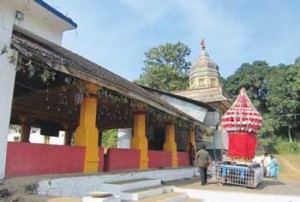
The Durga temple is situated in the Sadashivgad hill; along with the mythological significance, it also has an historic importance as it was established by the Maratha warrior Chhatrapatti Shivaji. He then gave the rights to worship, to the native Bhandari population. Another important temple is the Naganath temple, which is conserved under the Ancient Monuments and Archeological Sites and Remains Act of 1958.The natives can be found worshipping an anthill in the temple and it has high religious significance amongst the locals.
The Karwar Marine Aquarium
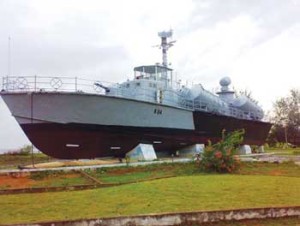
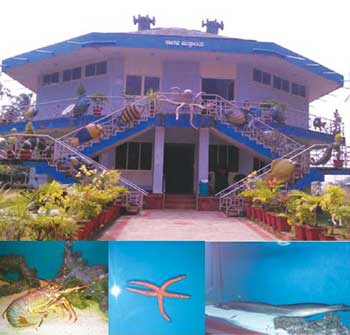
prawn, cat fish and star fish)
The Marine Aquarium at Karwar was established in 2000. A few common marine species are preserved in glass enclosure for the visitors to view. Crabs, lobsters, eels, starfishes, and sharks are some of the marine creatures found here. Karwar is a wonderful place to visit for all nature and sea food lovers. Its location also makes it a good tourist spot as it is on the way to Goa and the NH 17 highway passes through the town.
How to get there
One can take a flight to Mangalore and reach Karwar by road or one can take a flight to Goa and reach Karwar by road. The journey to Karwar is approximately 270 kms from Mangalore and just 85 kms from Goa. Karwar can also be reached by train, and its railway station connects to various Indian cities. The best time to visit Karwar is between October-February, after monsoon when there is greenery all over and the climate is pleasant. Karwar has many hotels to suit every budget. It is advisable to book rooms in advance, especially during the December and January months when the town has many visitors. Cabs can be hired at reasonable rates, the cab drivers are locals and also play the role of a guide and take tourists to the various attractions in and around Karwar.

